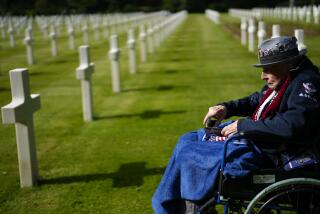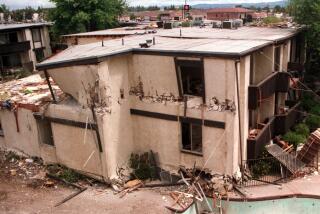Chase J. Nielsen, 90; aviator captured after Doolittle raid
Chase J. Nielsen, who spent 40 months as a prisoner of war after participating in the daring Doolittle raid that gave a much-needed lift to American morale only four months after the Japanese attack on Pearl Harbor, has died. He was 90.
Nielsen, a retired Air Force lieutenant colonel, died March 23 of age-related causes at his home in Brigham City, Utah, said his wife, Phyllis.
On the morning of April 18, 1942, 80 volunteer airmen on 16 B-25 Mitchell bombers took off from the deck of the aircraft carrier Hornet more than 600 miles from Japan. They took off earlier and about 200 miles farther out than they had planned. They were forced to move up the operation after the U.S. task force was spotted by Japanese patrol boats.
Nielsen, then a 25-year-old lieutenant, was the navigator for Crew No. 6.
Led by Lt. Col. James H. “Jimmy” Doolittle, the 16 planes successfully bombed targets in Tokyo and several other cities.
Because the bombers could not land on a carrier, plans originally called for them to land at airfields in China during the day. But with fuel running low because of the increased distance and bad weather, the airmen were forced to ditch their planes or bail out over the Chinese coast at night; one plane diverted to Russia.
Nielsen was in one of the two planes that were ditched off the coast, during which two men were killed.
Once in the water, according to a 1995 account in the Salt Lake Tribune, Nielsen became separated from his fellow crew members in the darkness. He was later found on shore by a Chinese guerrilla and soon joined up with his pilot and co-pilot. Japanese forces occupying China eventually captured them, and they, along with five other raiders, became prisoners of war.
“Being a prisoner was something I had never prepared for,” Nielsen told the paper. “It takes all the wind out of your sail, if you had anything left.”
Nielsen and his fellow prisoners, who were taken to Tokyo, were beaten and tortured while being interrogated. Among other things, Nielsen said in interviews, bamboo splints were shoved under his fingernails and then lighted on fire, and the bottoms of his feet were burned with hot coals.
Three of the eight American airmen were executed after a brief trial; Nielsen and the four others were sentenced to life in prison under solitary confinement and held in a small brick prison in Nanking, where one of them, weakened by dysentery, later died.
“I don’t think I was really afraid of dying,” Nielsen recalled in the 1995 interview. “The big thing was, ‘Who will even know what happened to me?’ ”
Nielsen and the other three imprisoned raiders were not freed until the end of the war. “Four Came Home,” a book by Carroll V. Glines, chronicles their story. Nielsen, whose decorations for the raid included the Distinguished Flying Cross, returned to China in 1946 to testify against his former captors in war crimes tribunals in Shanghai.
Born in Hyrum, Utah, Nielsen graduated from Utah State University with a bachelor’s degree in civil engineering in 1939. The same year, he enlisted in what was then the Army Air Corps as a flying cadet. He was commissioned as a second lieutenant in June 1941.
In 1949, he became a member of the Strategic Air Command at Roswell Air Force Base in New Mexico, where he was assigned to the 509th Bombardment Group, which was equipped and trained for atomic warfare.
After retiring from the Air Force in 1961, he worked as an industrial engineer at Hill Air Force Base in Utah.
Over the years, Nielsen frequently spoke about the Doolittle raid to school, civic and military groups.
“There were so many people who liked to hear his story, and he was happy to tell it,” said Phyllis Nielsen. He also attended as many of the Doolittle Raiders’ annual reunions as he could, she said.
As is the custom at the reunions, the surviving members conduct a private ceremony with 80 silver goblets, each of which is engraved with the name of a member.
After roll call, they solemnly toast the Doolittle Raiders who have died since their last gathering and then turn the deceased men’s goblets upside down.
When the time comes, the last two remaining Raiders will drink a final toast from a vintage bottle of cognac.
“I am proud to have been on the Doolittle raid,” Nielsen said at the reunion last year. “I am more proud to have been of service to my country. I hope and I pray that what we Doolittle Raiders have done will be an inspiration.”
At the next reunion, in San Antonio in April, the 14 surviving Doolittle Raiders will toast Nielsen and former Staff Sgt. William L. Birch, a bombardier on Crew No. 11, who died in November in Santa Ana.
In addition to his wife, Nielsen is survived by three children with his late first wife, Terry, Gregory and Sherrie Wendel; two sisters, Coy Scharp and Colleen Checketts; eight grandchildren and two great-grandchildren.
*
More to Read
Sign up for Essential California
The most important California stories and recommendations in your inbox every morning.
You may occasionally receive promotional content from the Los Angeles Times.










